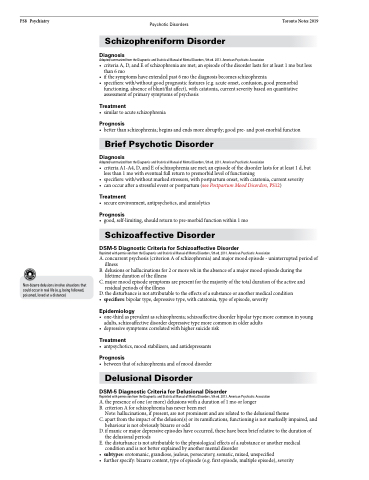Page 1172 - TNFlipTest
P. 1172
PS8 Psychiatry
Psychotic Disorders Toronto Notes 2019 Schizophreniform Disorder
Diagnosis
Adopted/summarized from the Diagnostic and Statistical Manual of Mental Disorders, 5th ed. 2013. American Psychiatric Association
• criteriaA,D,andEofschizophreniaaremet;anepisodeofthedisorderlastsforatleast1mobutless than 6 mo
• ifthesymptomshaveextendedpast6mothediagnosisbecomesschizophrenia
• specifiers:with/withoutgoodprognosticfeatures(e.g.acuteonset,confusion,goodpremorbid functioning, absence of blunt/flat affect), with catatonia, current severity based on quantitative
assessment of primary symptoms of psychosis
Treatment
• similartoacuteschizophrenia
Prognosis
• betterthanschizophrenia;beginsandendsmoreabruptly;goodpre-andpost-morbidfunction
Brief Psychotic Disorder
Diagnosis
Adopted/summarized from the Diagnostic and Statistical Manual of Mental Disorders, 5th ed. 2013. American Psychiatric Association
• criteriaA1-A4,D,andEofschizophreniaaremet;anepisodeofthedisorderlastsforatleast1d,but less than 1 mo with eventual full return to premorbid level of functioning
• specifiers:with/withoutmarkedstressors,withpostpartumonset,withcatatonia,currentseverity
• canoccurafterastressfuleventorpostpartum(seePostpartumMoodDisorders,PS12)
Treatment
• secureenvironment,antipsychotics,andanxiolytics
Prognosis
• good,self-limiting,shouldreturntopre-morbidfunctionwithin1mo
Schizoaffective Disorder
DSM-5 Diagnostic Criteria for Schizoaffective Disorder
Reprinted with permission from the Diagnostic and Statistical Manual of Mental Disorders, 5th ed. 2013. American Psychiatric Association
A. concurrent psychosis (criterion A of schizophrenia) and major mood episode - uninterrupted period of illness
B. delusions or hallucinations for 2 or more wk in the absence of a major mood episode during the lifetime duration of the illness
C. major mood episode symptoms are present for the majority of the total duration of the active and residual periods of the illness
D. the disturbance is not attributable to the effects of a substance or another medical condition • specifiers:bipolartype,depressivetype,withcatatonia,typeofepisode,severity
Epidemiology
• one-thirdasprevalentasschizophrenia;schizoaffectivedisorderbipolartypemorecommoninyoung adults, schizoaffective disorder depressive type more common in older adults
• depressivesymptomscorrelatedwithhighersuiciderisk
Treatment
• antpsychotics,moodstabilizers,andantidepressants
Prognosis
• betweenthatofschizophreniaandofmooddisorder
Delusional Disorder
DSM-5 Diagnostic Criteria for Delusional Disorder
Reprinted with permission from the Diagnostic and Statistical Manual of Mental Disorders, 5th ed. 2013. American Psychiatric Association
A. the presence of one (or more) delusions with a duration of 1 mo or longer
B. criterion A for schizophrenia has never been met
Note: hallucinations, if present, are not prominent and are related to the delusional theme
C. apart from the impact of the delusion(s) or its ramifications, functioning is not markedly impaired, and
behaviour is not obviously bizarre or odd
D. if manic or major depressive episodes have occurred, these have been brief relative to the duration of
the delusional periods
E. the disturbance is not attributable to the physiological effects of a substance or another medical
condition and is not better explained by another mental disorder
• subtypes:erotomanic,grandiose,jealous,persecutory,somatic,mixed,unspecified
• furtherspecify:bizarrecontent,typeofepisode(e.g.firstepisode,multipleepisode),severity
Non-bizarre delusions involve situations that could occur in real life (e.g. being followed, poisoned, loved at a distance)


